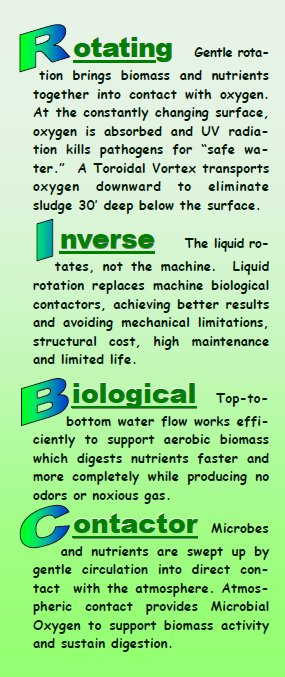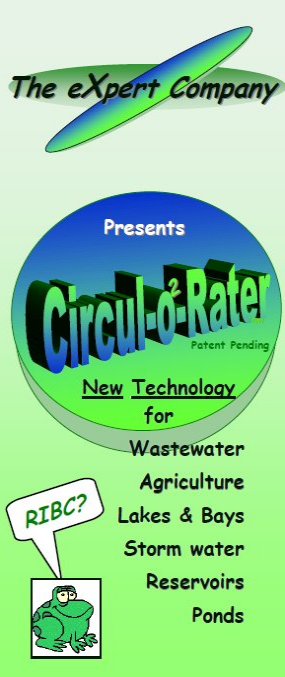Lakes & Ponds
“57% of the Lakes in the United States are impaired”, like this lake.




The floating Circul-O2-Ratortm induces Toroidal Liquid Circulationtm
(TLCtm) to deliver the benefits of Oxygenation, Circulation and UV Exposure.
• A toroidal vortex gently sweeps across the bottom collecting available nutrients.
• Enzymatic nutrients travel up the vortex, mixing with aerobic microbes.
• At the surface, nutrients, microbes and water are enriched with oxygen.
• The biomass travels outward in direct contact with atmospheric oxygen and into quiescent waters where microbial digestion readily occurs.
• On the surface, pathogens are deactivated and large molecules degraded by repeated exposure to UV radiation from sunlight.
• Downward flows move colonizing algae off the surface to prevent algae bloom.
• Cross flows carry dissolved oxygen and aerobic microbes across the bottom of the pond to digest sludge and avoid costly mechanical removal.
• Toroidal Liquid Circulation” (TLCtm ) combines microbes into bio-fluts and bio-films where complex microbial transformations and further large molecule degradation occur.
The RIBCtm process combines continuous surface renewal and re-oxygenation with gentle, Toroidal Liquid Circulationtm (TLCtm ) to maintain a fully aerobic water column and avoid dead spots where sludge can accumulate to release offensive gasses and odors. With good design each unit circulates 9+ million gallons of water and supplies 20Ibs of Dissolved Oxygen (DO) per hour, plus an estimated 5lbs of microbial oxygen from direct atmospheric contact. One Crni-aRatertm supports reduction of up to 20Ibs of BOD per hour. UV exposure from sunlight aids in pathogen reduction and harmful large molecule degradation.
RBIC 9000 Circul-O2-Ratertm

EQUIPMENT INFORMATION SHEET
Floating Oxygenation Circulator
RBIC 9000 Series Circul-O2-Ratertm
Manufacturer: The eXpert Company Inc. Circul-O2-Ratertm Division
Model: RBIC 9000 Series
Horsepower: Fractional, operating up to 1 hp/unit
Pumping: 6,266 gallons per minute to the surface
Circulation: Toroidal Vortex, Min: 9m3/S = 318 ft3/S or 8.5 million gallons/hour
Oxygen Transfer, Mixing and Dispersion:
Standard Oxygen Transfer = 20Ibs/hr of Dissolved + 5 lbs/hr Microbial Oxygen
Oxygen Dispersion – Radius/Unit Mixing Zone – Radius/unit Nominal +750′ Nominal +750′
Effective Depth Min 6′ Max 33’+
BOD reduction @ 770F water temp at sea level:
Est: 15Ibs DO + 5Ibs Microbial/hrx24 = 480Ibs/unit/day
Additional Benefits:
Energy Savings: 90% of blower/aspirator/venturi usage
Pathogen reduction and large molecule degradation
Recycle “safe water” for beneficial use
* Rotating Inverse Biological Contactor (RIBC”) labeled “inverse” because the liquid itself rotates and tumbles its microbial contents into direct biological contact with atmospheric oxygen and UV sunlight. By contrast, ordinary Rotating Biological Contactors (RBC’s) utilize solid rotating disks to establish contact with the atmosphere. The RIBC’m contact surface is calculated as the “area of influence” x “frequency of surface renewal.” RIBOr’ easily delivers more BOD reduction than expected from disk based RBC devices and is not subject to bearing wear-out, or maintenance required for large rotating machines.
BIO-SEDIMENT REDUCTIONtm
“The Key to a Clean Lake!”
What is Bio-Sediment Reductions (BSRtm)?
Bio-Sediment Reductiontm (BSRtm) is the process of re-oxygenating a lake or pond to stimulate and sustain naturally occurring aerobic microbial activity. Nothing is added to, moved or taken out of the lake! With enhanced oxygen and circulation, aerobic micro-organisms rapidly digest sludge and muck from the bottom. To accomplish this, oxygen collected from the surface is transported downward and across the sediment to provide the oxygen required for aerobic micro-organisms to complete their environmental duties.
Bio-Sediment Reductiontm mimics lake turn-over, which naturally re-oxygenates lakes in spring, fall or when wind blows long enough. The tremendous cleaning power of nature is evident when turn-over and re-oxygenation is maintained continuously, instead of only a few times a year. As muck and sediment are reduced, lakes and ponds return to normal. The water becomes clearer and provides fewer nutrients for weed and algae growth. As sunlight penetrates the clear water, more diverse native species return.
Sludge and Muck — where does it come from?
Organic sediments from dead aquatic weeds and algae as well as leaves, branches, grass, dead fish and water fowl droppings that sink to the bottom of the lake decay to form muck and sludge. As lakes age, sludge and muck increase the organic content of the sediment layer.
Weeds and Algae Growth — caused by Muck and Sludge?
Aquatic environments provide favorable conditions for plant growth. Each acre of algae, for example, naturally adds 30 lbs of nitrogen each year. Dead weeds and algae sink to the bottom decaying into muck and sludge. Without oxygen, decomposition releases nitrogen and phosphorous back into the water to grow more weeds.
How does Nature Clean up Muck and Sludge?
Nature cleans up muck in two ways. Flowing water eliminates muck by moving nutrient matter elsewhere, usually depositing it into a lake. Streams re-oxygenate themselves continuously to support aerobic micro-organisms that need oxygen and digest organic matter without releasing nutrients back into the water. Aerobic microbes are then consumed by zooplankton. These microscopic animals also require oxygen to survive and eat other micro-organisms. Zooplankton in turn are consumed by higher forms of aquatic life including snails, mussels, crabs, fish. birds and mammals. That is how streams stay clean.
However lakes and ponds have less moving water and less reoxygenation to clean themselves. Dead weeds and algae continually add to the sediment layer of black smelly muck. Nutrients recycle back year after year similar to the way farmers use crop residue to provide nutrients for next year’s growth. Without help, lakes can become eutrophic as they continue to fill up with weeds, algae, muck and sludge.
What does Bio-Sediment Reductiontm do for your Lake?
Bio-Sediment Reductiontm is a safe, natural, non-intrusive and permanent solution to lake problems. BSR” digests muck and sludge and slows weed and algae growth. BSR” offers a reliable, low cost alternative to dredging, weed cutting and draw-downs. Lake use is not interrupted. The benefits are many and the negatives are none. What could be better than that?
Bio-Sediment Reductiontm
“The Permanent Solution for Lake Rehabilitation!”
Without Bio-Sediment Reduction” lakes collect muck, algae, weeds and pathogens! In 1998 the Health Department shut down the beach at Pointe Calumet, Quebec!

Benefits of Bio-Sediment Reductiontm
Provides a healthier lake with clear water, more fish, fewer weeds and less algae.
Aerobic microbes consume organic sediment — muck and sludge are not moved to another location.
